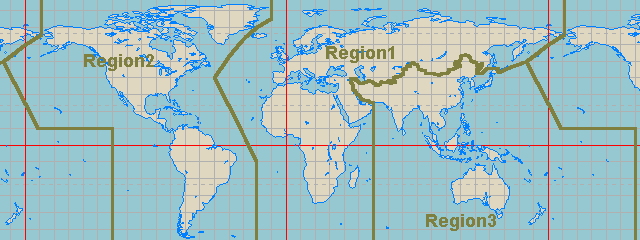Regulations
International Maritime Organization
Under the scope of the SOLAS - GMDSS recommendations,
the International Maritime
Organization in London has specified the required radio equipment for
commercial vessels.
These recommendations are valid generally for all passenger vessels and all cargo ships
over 300 gross tonnages on international voyages.
Specific equipment requirements for ships vary according to the sea area in which the ship operates. For this purpose the oceans are divided into four sea areas:
Vessels cruising in Area 2 waters will additionally carry MF/HF communication
equipment (SSB) with DSC capability.
SOLAS compliance for Area 3 requires satellite communication equipment (INMARSAT A or C).
Vessels sailing in polar waters (Area 4) will carry special long-range HF-SSB radio with
DSC capability.
Smaller ships and pleasure yachts are not required to have GMDSS equipment installed, including maritime radio, but they may be equipped by choice and can then participate in the GMDSS giving access to the global Search-and-Rescue facilities. International Telecommunication Union
The International Telecommunication Union
(ITU), headquartered in Geneva, Switzerland is an international organization within the United
Nations Organization, where governments and the private sector coordinate global telecom
networks and services.
The regulations, resolutions and recommendations of the ITU and its
decision boards on radio communication (ITU-R) are published in
he international Radio Regulations.
They cover both legal and technical issues, and serve as a
supra-national instrument for the optimal world-wide management
of the radio spectrum.
For the allocation of frequencies and communication services,
the world has been divided into three regions:

This separation allows for flexible and optimal usage of the
available frequency bands in each of the regions, but may result
in incompatibilities between the regions on some radio channels.
For this reason, equipment bought in one region may not fully
comply to the regulations valid in the other regions.
This should be taken into account, when cruising over the region
boundaries.
The ITU has also allocated some dedicated radio frequencies for the purpose of marine communication. They cover the MF, HF and VHF radio bands. Due to the propagation characteristics of the electromagnetic radio waves, these different frequency bands are typically used as follows: MF and HF are well suited for long-range and even world-wide communication, whereas VHF radio can only be used for short-range communication. div align="justify">In the VHF range, the ITU has established about 55 channels for marine purposes. Three of these radio channels are recognized worldwide for safety purposes:
Except for distress and safety purposes, the ITU has not allocated special
services to these marine radio frequencies.
The allocation of radio channels to certain marine services such as Vessel Traffic Control
(VTS) or the port authorities is established by the national communication administrations.
Therefore, there is no general international assignment of channels to services and although
there is a widely accepted agreement on the
usage of the different VHF channels,
in many countries this assignment may not comply with national or local regulations
(e.g. in port areas).
It is the radio operator's responsibility to be informed on - and to comply to - the
local radio regulations before radio transmissions are conducted.
For long-range communication, the ITU has allocated about 160 channels in different MF/HF frequency bands for marine radio. The channels are located in the 2-MHz MF band and the 4-, 6-, 8-, 12-, and 16-MHz HF bands. The calling and safety channels for initial contact with other stations or for emergency communication are at: 2182, 4125, 6215, 8291, 12290, and 16420 kHz using USB modulation. Licenses and Permits for Communication EquipmentIt is a legal requirement to have a ship's radio station license
and marine radio operator's certificate before radio transmitting equipment
is used on a yacht.
The ship's radio license will document the vessel's international call sign and,
if requested, also the 9 digit MMSI number to participate in the Digital Selective Calling
network of GMDSS.
Radio station call signs and MMSI numbers are internationally allocated.
Call sign or MMSI number of a particular vessel may be obtained from the
web site of the International Telecommunications Union (ITU).
div align="justify">To participate in nationally regulated communication networks, the radio equipment must be Type Approved by the national telecommunications authorities. This is documented in the license of the radio installation and also by the manufacturer in the delivery documents of the equipment. In Europe, the following operating certificates for marine radio equipment with DSC capability can be obtained:
International Radio Watch keeping Regulations
After the introduction of GMDSS, and its full deployment - for commercial vessels -
since 1 February 1999,
the compulsory watch keeping on the distress calling channels has been abolished.
By adoption of IMO resolution MSC 77 (69), May 1998, the Maritime Safety Committee
urges all governments to encourage seagoing vessels being voluntarily fitted with
VHF radio equipment to be fitted also with facilities for transmitting and receiving
distress alerts by DSC on VHF channel 70 no later than 1 February 2005.
Both the International Telecommunication Union and the International Maritime Organization have each established marine radio watch keeping regulations taking into account that not yet all vessels - especially pleasure boats - are equipped with GMDSS equipment. These regulations include to continue a voluntarily watch keeping on the traditional distress channels "where practicable". Notice however, that national regulations may override this rule and may require to maintaining a watch on the distress channels whenever the radio is not being used to communicate and whenever the vessel is underway. Publications
The most extended publication on maritime communication issues is
the "Admiralty - List of Radio Signals" published by the
United Kingdom Hydrographic Office.
The complete work consists of 6 bands:
Most bands are revised annually and can be kept up-to-date from the weekly
"Admiralty Notices to Mariners".
The price (as of 2008) is about 60 Euro per Band.
| ||||
| Cover << Sail Away << Marine Radio Communication << . | .>> Radio Principles | last updated: 10-Feb-2008 |
